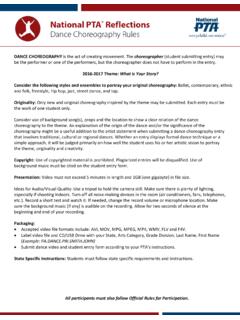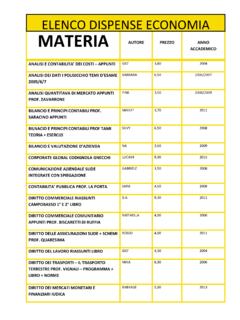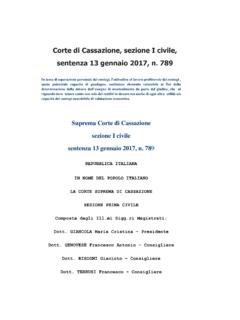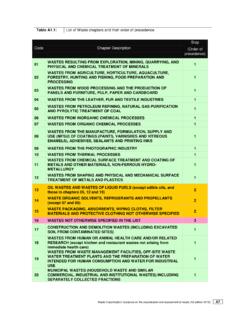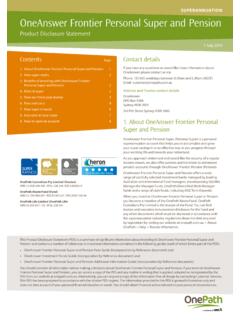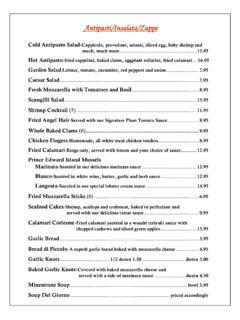Transcription of The Order of Fasts in Ethiopian Orthodox Tewahido Church
1 THE Order OF Fasts IN Ethiopian Orthodox . ). Tewahido Church ( . 7 March 2013 at 23:09.. THE Order OF Fasts IN Ethiopian Orthodox Tewahido Church ( . ).. Fasting is abstinence from all things a body needs, and one has to fast from animal products and from any kind of food for a limited time until the period of fasting is over. (Fetha Negest 15, Mt. 6:16). In general, one has to abstain from any thing which the body desires. The aim of fasting is to make the desire of the body to obey the will of the soul, to seek forgiveness of guilt and to increase the reward of the soul. Fasting has perpetual relation with religion. Even though the way it is practiced differs from religion to religion, anyone who has religion practices fast. Especially in the Old Testament, fasting had a prominent place in the lives of the Jewish people. Whenever the Old Testament prophets sought to communicate with God, they neither ate food nor drank water.
2 (Ex. 34:28). The wrath of God that comes about as a result of sin can be averted through solemn prayer and rigorous fasting. (Jon. 3:7-10; Joel 2:15). In the New Testament also, fasting is not a law made by man. It is our Savior Jesus Christ himself who made it the beginning of His messianic ministry in his earthly life. (Mt. 4:2; Lk. 4:2). Our Savior Jesus Christ has taught that fasting has the power of driving away evil spirits. (Mt. 17:21;. Mk. 9:2). The Apostles who were commanded to serve the Church received guidance from the Holy Spirit while they were praying and fasting. (Acts 13:2). Priests and deacons who served as preachers of the gospel were inspired and ordained while fasting and praying. (Acts 13:3; 14:23). It was through fasting and beseeching God that righteous people received what they needed and whished. (Ezra. 8:21; Ne. 9:1-3; Est. 4:16-17; Acts 10:30; 13:2-3). As the theological interpretation of fast is beseeching God and asking him for the forgiveness of sin, it is therefore, mandatory to abstain from animal products and alcoholic drinks which incite lust.
3 (Dan. 10:2-3). Fasting has been taught and practiced in the teachings of the apostles and Church Fathers. (The Law of Kings Art. 15; Didas. 29). As it is said, Blessed is he who Fasts to feed the poor , if any fasting man gives what he has allocated for his lunch and supper to the organization of the disabled founded by the Church or to the poor, his fast will be more complete. (Isa. 58:6-11). Fasting is not only abstinence from food. It will be a true fast if the eye is kept from seeing, the mouth from speaking and the ear from hearing evil things. (Mt. 5:21-30; St. Yared-Digua). The Ethiopian Orthodox Tewahedo Church has its own laws and orders of fasting. Accordingly, there are seven fasting periods. 1. The Great Fast (Lent).. 2. Wednesday and . 3.. 4. Gehad (the eves of Christmas and Epiphany).. 5. The fast of the prophets or . 6. The fast of the Apostles .. 7.. The fast of the Assumption of the Holy Virgin Mary.
4 A. Lent or the Great Fast( . May the Lord be praised; this is the fast that our Lord and Savior Jesus Christ fasted for forty days and nights after his baptism. (Mt. 4:1). The Church observes this fast following the example of our Lord. The Great Fast has 8 weeks which consist of 55 days. The first week is known as the fast of Eraclius, the Byzantine Emperor who lived in 614 This fast is dedicated to Eraclius for the following reasons. During his reign the Persians invaded Jerusalem and took the Cross of the Lord. Eraclius made an expedition to Persia and having defeated the Persians he took the Cross back to Jerusalem. The Christians in Jerusalem who were very happy because of Eraclius's victory and the return of the Cross, dedicated the first week before Lent to be the fast of Eraclius and included it in their canons. Thus our Church has accepted and included it in her canon to be a part of Lent. (Fitha Negest Art.))
5 15). The last week of Lent is called Passion Week ( ) during which the Apostles fasted in commemoration of Christ's Passion. This is also regarded as part of the Great Fast. Thus Lent is called great because firstly, it is the Lord's fast. Secondly, through this fast Satan's temptation (love of money, greediness and arrogance) are overcome. All Christians, young and old have to observe the fast of the Lord. St. Yared, the Ethiopian hymnologist who wrote the hymn of our Church has composed in his hymn book known as Tsome Digua (Hymn of Fast) songs for each Sunday of the Great Fast. So each Sunday during the Great Fast is named after the song of that Sunday. The first Sunday of the Great Fast is known as the Zewerede= ( Zewerede means the one who descended from above). In the beginning of his hymn book, Tsome Digua, St. Yared mentions the descent, incarnation and crucifixion of the Lord. (Jn. 3:13). The second Sunday is called Kidist=.
6 Kidist means holy. It tells the holiness of Sunday. We call the third Sunday Mikurab= . The word Mikurab stands for the synagogue. It reminds us that our Lord during his ministry taught in the synagogue. The forth Sunday is known as Mesague= Mesague means one who is infirm. (Jn. 5:1-9). A hymn for the healing of the sick and giving sight to the blind by the Lord is sung on this day. The fifth Sunday is called Debre Zeit= . Debre Zeit is the Geez word for Mount of Olives. A hymn of our Lord's second coming which he taught on Mount Olives is sung on this day. We call the sixth Sunday "Gebr Her= " Good Servant . The story of the good servant who received five talents and made a profit of five more talents is told and sung on this day. (Mt. 25:14-30). The seventh Sunday is called Nicodimus= . A hymn commemorating the coming of Nicodimus to our Lord during the night is sung. The eighth Sunday is "Hosaena= " Palm Sunday.
7 It is a commemorative day on which our Lord entered into the temple in triumph and during which the people sung Hosanna in the highest . The week from the eve of Palm Sunday to Easter is known as Semune Himamat= . - Passion Week. On these days, varieties of food are not eaten. Adoration is given to God. A book known as Gibrehimamat composed of different passages taken from the Scriptures and other religious books dealing with the passion and death of our Lord is read. The altar is covered with a black cloth in rememberance of the dark centuries during which Adam was alienated from his Crator. The priests wear black vestments. As this week is a time of commemorating of the suffering and damnation of 5500 years, prayer for the dead and that of intercession are not said. Such prayers are said only on Palm Sunday. Misete hamus -Maundy Thursday It is a day on which the Lord Jesus in absolute humility washed His Disciples's feet, ate the Last Supper with them and revealed the mystery of the Holy Eucharist.
8 On this day the Liturgy is celebrated. Before the Liturgy, the priest brings water in a basin and saying the prayer of thanksgiving, washes the feet of the faithful. When the Liturgy is over, the faithful leave for home after benediction. On the morrow of Thursday, Good Friday, in remembrance of Chris's crucifixion an Epitaphion (crucifix) is made and passages from the Scriptures and other religious books are read. The faithful prostrate every now and then. Good Friday is sometimes called a day of prostration. Towards the evening (at about 4:30 ), the faithful approach a priest to be patted with small branches of olive trees. Patting the faithful in this way symbolizes the whipping of our Lord. Then the faithful say God have mercy upon us 400 times. After hymns are sung and readings assigned for the day are read, the song, Let us praise the Lord is sung. With the exception of kissing of the cross, sinners confess their sins and after that absolution is said.
9 Next prayer of intercession is conducted and the people are dismissed at 6. (Fetha Negest Art. 15 No. 601). The Apostles did not eat and drink until they knew of the resurrection of the Lord. In accordance with this practice, Ethiopian Orthodox Christians who have the strength to abstain from every kind of food for two days can fast on both Friday and Saturday. But those who have not the strength fast on Saturday only. (Lk. 5:5-35; Fetha Negest Art. 15 No. 578). On Saturday morning, the laity and the clergy gather in the Church . After the appropriate morning prayer is over, the clergy singing the song Christ made reconciliation by his crucifixion give sedge to the people assembled, as a symbol of good tidings. The faithful tie the sedge round their heads. The clergy wearing their vestments, holding a cross and ringing a bell go to the houses of the people who did not come to the Church and give them the sedge as a symbol of good news.
10 As the former Sabbath was the day on which God rested from His work after creating all creatures, this Sabbath is the day which Christ passed lying in the grave after completing his messianic ministry in three years and three months. This day is called Kidame Se'ur (unobserved) Saturday. It is called so because once a year it becomes a fast day. It is also called Green Saturday for on this day the sedge is given out. The fact that the sedge is the symbol of good news is related to Biblical history. As the Bible tells us, when the earth was covered with the water of destruction and Noah's Ark was floating on the flood; to see if the flood had subsided Noah opened the window of the ark and sent forth a dove. The dove returned with an olive leaf and knowing that the water had abated Noah became happy and began to rest his ark. As the leaf of the olive tree served as the sign of congratulation at the time of Noah, by the death of Christ, the water of destruction, sin and the punishment of soul is removed from mankind.
